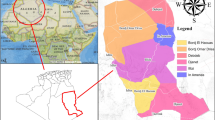Abstract
Evapotranspiration is a major factor that controls hydrological process and its accurate estimation provides valuable information for water resources planning and management, particularly in extremely arid regions. The objective of this research was to evaluate the use of a support vector machine (SVM) to model daily reference evapotranspiration (ET0) using limited climatic data. For the SVM, four combinations of maximum air temperature (T max ), minimum air temperature (T min ), wind speed (U 2 ) and daily solar radiation (R s ) in the extremely arid region of Ejina basin, China, were used as inputs with T max and T min as the base data set. The results of SVM models were evaluated by comparing the output with the ET0 calculated using Penman–Monteith FAO 56 equation (PMF-56). We found that the ET0 estimated using SVM with limited climatic data was in good agreement with those obtained using the conventional PMF-56 equation employing the full complement of meteorological data. In particular, three climatic parameters, T max , T min , and R s were enough to predict the daily ET0 satisfactorily. Moreover, the performance of SVM method was also compared with that of artificial neural network (ANN) and three empirical models including Priestley-Taylor, Hargreaves, and Ritchie. The results showed that the performance of SVM method was the best among these models. This offers significant potential for more accurate estimation of the ET0 with scarce data in extreme arid regions.




Similar content being viewed by others
References
Adeloye AJ, Rustum R, Kariyama ID (2012) Neural computing modeling of the reference crop evapotranspiration. Environ Model Softw 29(1):61–73
Allen RG, Smith M, Pereira LS (1994) An update for the definition of reference evapotranspiration. ICID Bull 43:1–34
Allen RG, Pereira LS, Raes D, Smith M (1998) Crop evapotranspiration-guidelines for computing crop water requirements. FAO irrigation and drainage. paper no. 56. FAO, Rome
Boser, B.E., Guyon, I.M., Vapnik, V.N., (1992) A training algorithm for optimal margin classifiers. Proceedings of the Fifth Annual Workshop on Computational Learning Theory. ACM Press, pp.144–152
Chang CC, Lin CJ (2011) LIBSVM: a library for support vector machines. ACM Trans Intell Syst Technol 2:1–27, Software available at http://www.csie.ntu.edu.tw/~cjlin/libsvm
Chauhan S, Shrivastava RK (2008) Performance evaluation of reference evapotranspiration estimation using climate based methods and artificial neural networks. Water Resour Manag 23(5):825–837
Citakoglu H, Cobaner M, Haktanir T, Kisi O (2013) Estimation of monthly mean reference evapotranspiration in Turkey. Water Resour Manag 28(1):99–113
Cobaner M (2011) Evapotranspiration estimation by two different neuro-fuzzy inference systems. J Hydrol 398:292–302
El-Shafie A, Najah A, Alsulami HM, Jahanbani H (2014) Optimized neural network prediction model for potential evapotranspiration utilizing ensemble procedure. Water Resour Manag 28(4):947–967
Hargreaves GH, Samani ZA (1985) Reference crop evapotranspiration from temperature. Appl Eng Agric 1(2):96–99
Haykin S (1999) Neural network-a comprehensive foundation. Prentice-Hall, Englewood Cliffs
He Z, Wen X, Liu H, Du J (2014) A comparative study of artificial neural network, adaptive neuro fuzzy inference system and support vector machine for forecasting river flow in the semiarid mountain region. J Hydrol 509:379–386
Hou LG, Xiao HL, Si JH, Xiao SC, Zhou MX, Yang YG (2010) Evapotranspiration and crop coefficient of Populus euphratica Oliv forest during the growing season in the extreme arid region northwest China. Agric Water Manag 97(2):351–356
Hsu, C.W., Chang, C.C., Lin, C.J., (2010). A practical guide to support vector classification. URL http://www.csie.ntu.edu.tw/~cjlin/papers/guide/guide.pdf.
Jain A, Indurthy SKVP (2003) Comparative analysis of eventbased rainfall-runoff modeling techniques-deterministic, statistical, and artificial neural networks. J Hydrol Eng ASCE 8(2):93–98
Jones, J.W., Ritchie, J.T., (1990) Crop growth models. Management of farm irrigation systems. In: Hoffman, G.J., Howel, T.A., Solomon, K.H. (Eds.), ASAE Monograph No. 9. ASAE, St. Joseph, Mich., pp.63–89
Kisi O (2012) Least squares support vector machine for modeling daily reference evapotranspiration. Irrig Sci. doi:10.1007/s00271-012-0336-2
Kisi O, Cengiz TM (2013) Fuzzy genetic approach for estimating reference evapotranspiration of Turkey: Mediterranean Region. Water Resour Manag 27(10):3541–3553
Kisi O, Cimen M (2009) Evapotranspiration modeling using support vector machines. Hydrol Sci J 54(5):918–928
Laaboudi A, Mouhouche B, Draoui B (2012) Neural network approach to reference evapotranspiration modeling from limited climatic data in arid regions. Int J Biometeorol 56(5):831–841
Lin GF, Lin HY, Wu MC (2013) Development of a support-vector-machine-based model for daily pan evaporation estimation. Hydrol Process 22:3115–3127
López-Urrea R, de Santa M, Olalla F, Fabeiro C, Moratalla A (2006) Testing evapotranspiration equations using lysimeter observations in a semi-arid climate. Agric Water Manag 85:15–26
Müller K, Smola A, Rätsch G, Schölkopf B, Kohlmorgen J, Vapnik VN (1997) Predicting time series with support vector machines. Artif Neural Networks—ICANN 97(1327):999–1004
Priestley CHB, Taylor RJ (1972) On the assessment of surface heat flux and evaporation using large scale parameters. Mon Weather Rev 100:81–92
Principe JC, Euliano NR, Lefebvre CW (2000) Neural and adaptive systems: fundamentals through simulations. Wiley, New York
Raghavendra NS, Deka PC (2014) Support vector machine applications in the field of hydrology: a review. Appl Soft Comput 19:372–386
Rahimikhoob A (2014) Comparison between M5 model tree and neural networks for estimating reference evapotranspiration in an arid environment. Water Resour Manag 28(3):657–669
Si JH, Feng Q, Zhang XY, Liu W, Su YH, Zhang YW (2005) Growing season evapotranspiration from Tamarix ramosissima stands under extreme arid conditions in northwest China. Environ Geol 48(7):861–870
Tabari H, Kisi O, Ezani A, Hosseinzadeh Talaee P (2012) SVM, ANFIS, regression and climate based models for reference evapotranspiration modeling using limited climatic data in a semi-arid highland environment. J Hydrol 444–445:78–89
Vapnik VN (1995) The nature of statistical learning theory. Springer, New York
Acknowledgments
This work was funded by the National Basic Research Program of China (2013CB429906), the authors also wish to thank anonymous reviewers for their reading of the manuscript and for their suggestions and critical comments.
Author information
Authors and Affiliations
Corresponding authors
Rights and permissions
About this article
Cite this article
Wen, X., Si, J., He, Z. et al. Support-Vector-Machine-Based Models for Modeling Daily Reference Evapotranspiration With Limited Climatic Data in Extreme Arid Regions. Water Resour Manage 29, 3195–3209 (2015). https://doi.org/10.1007/s11269-015-0990-2
Received:
Accepted:
Published:
Issue Date:
DOI: https://doi.org/10.1007/s11269-015-0990-2




